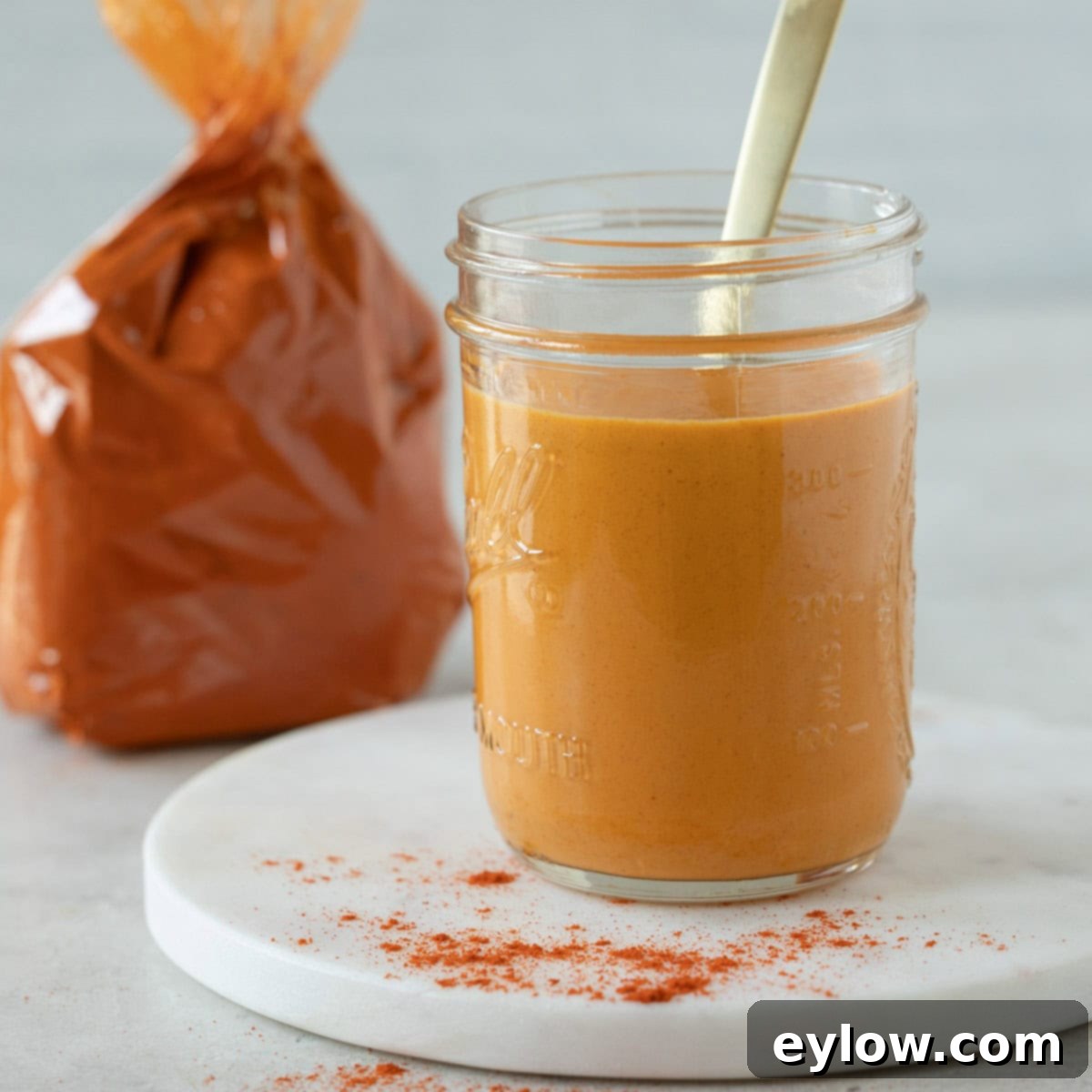Authentic Hungarian Creamy Paprika Sauce: An Easy 25-Minute Recipe for Culinary Delight
Prepare to be enchanted by the vibrant orange hue and rich, velvety texture of this incredible paprika sauce. Its stunning color and deep, aromatic flavor are a direct tribute to authentic Hungarian paprika – often underestimated as merely a decorative sprinkle for dishes like deviled eggs. Here, it takes center stage, proving its versatility and depth as the star ingredient in a sauce that promises to elevate any meal. Ready in a remarkable 25 minutes, this easy-to-make sauce is an indispensable companion for everything from lean meats and succulent chicken to delicate fish and various seafood, infusing each bite with its beautiful flavor and captivating visual appeal.

My journey into the world of truly exceptional paprika began when dear Hungarian friends presented me with a bag of fresh, intensely fragrant paprika directly from Budapest. The moment I opened it, I was utterly captivated by its vivid color and intoxicating aroma. It was a revelation – a world apart from the often dull, dusty, and flavorless paprika I had grown accustomed to finding in standard grocery stores. This experience fundamentally reshaped my perception of this versatile spice.
While smoked paprika had long been a staple in my kitchen, traditional sweet paprika often lingered on the shelf, waiting for its moment to shine. That moment arrived with this game-changing gift. Crafting this authentic paprika cream sauce is not only incredibly simple but also remarkably rewarding, producing a versatile condiment you’ll find yourself reaching for time and time again to transform everyday meals into something extraordinary. This recipe is designed to celebrate the true essence of high-quality paprika, making it a staple in your culinary repertoire.
If you’re eager to jump straight to the full recipe and ingredient list, click the link below:
[feast_advanced_jump_to]
Why You’ll Adore This Creamy Paprika Sauce Recipe
This Hungarian-inspired paprika sauce, also affectionately known as paprika cream sauce, is more than just a condiment; it’s a culinary staple that brings warmth, flavor, and a touch of elegance to countless dishes. Here’s why it’s destined to become a favorite in your kitchen:
- Effortlessly Easy to Make: Despite its sophisticated flavor, this sauce is surprisingly straightforward, requiring minimal fuss and simple cooking techniques. Even novice cooks can achieve a restaurant-quality result in just 25 minutes.
- Unparalleled Versatility: This creamy sauce is a chameleon in the kitchen. It pairs magnificently with a wide array of proteins, from robust red meats and tender chicken to delicate fish and various seafood. Beyond that, consider it a luxurious topping for poached eggs, a flavor booster for omelets, or a delightful accompaniment for roasted vegetables and pasta.
- Showcases High-Quality Paprika: This recipe truly allows premium paprika to shine, highlighting its nuanced sweet and earthy notes. It’s an ideal way to appreciate the difference that fresh, authentic Hungarian paprika can make.
- Authentically Hungarian Approved: Developed with input and approval from Hungarian friends, this recipe captures the true essence of traditional paprika sauces, ensuring an authentic taste experience that honors its heritage.
Chef’s Tip on Buying Paprika for Optimal Flavor: The quality of your paprika is paramount to the success of this sauce. To ensure you’re getting the best, always prioritize real Hungarian paprika packaged in tins or opaque, solid bags. These containers protect the delicate spice from light exposure, which can quickly degrade its vibrant color and potent flavor. Avoid clear bags or jars, as they offer little protection. Once purchased, store your paprika in a cool, dark place, away from direct sunlight and heat, to maintain its peak freshness and aromatic intensity for as long as possible. A well-stored paprika ensures the brilliant color and deep flavor your sauce deserves.
If you enjoy creating rich, flavorful sauces from scratch, you might also love this homemade cocktail sauce for seafood, or this versatile gluten-free Hoisin sauce, perfect for Asian-inspired dishes. These recipes, like our paprika sauce, showcase how homemade condiments can transform meals.
Essential Ingredients for Your Creamy Paprika Sauce
Crafting this delightful sauce requires a handful of simple, high-quality ingredients. Each plays a crucial role in building the layered flavors and achieving the perfect creamy consistency that defines this Hungarian classic. Sourcing the best ingredients will truly make a difference in the final taste.
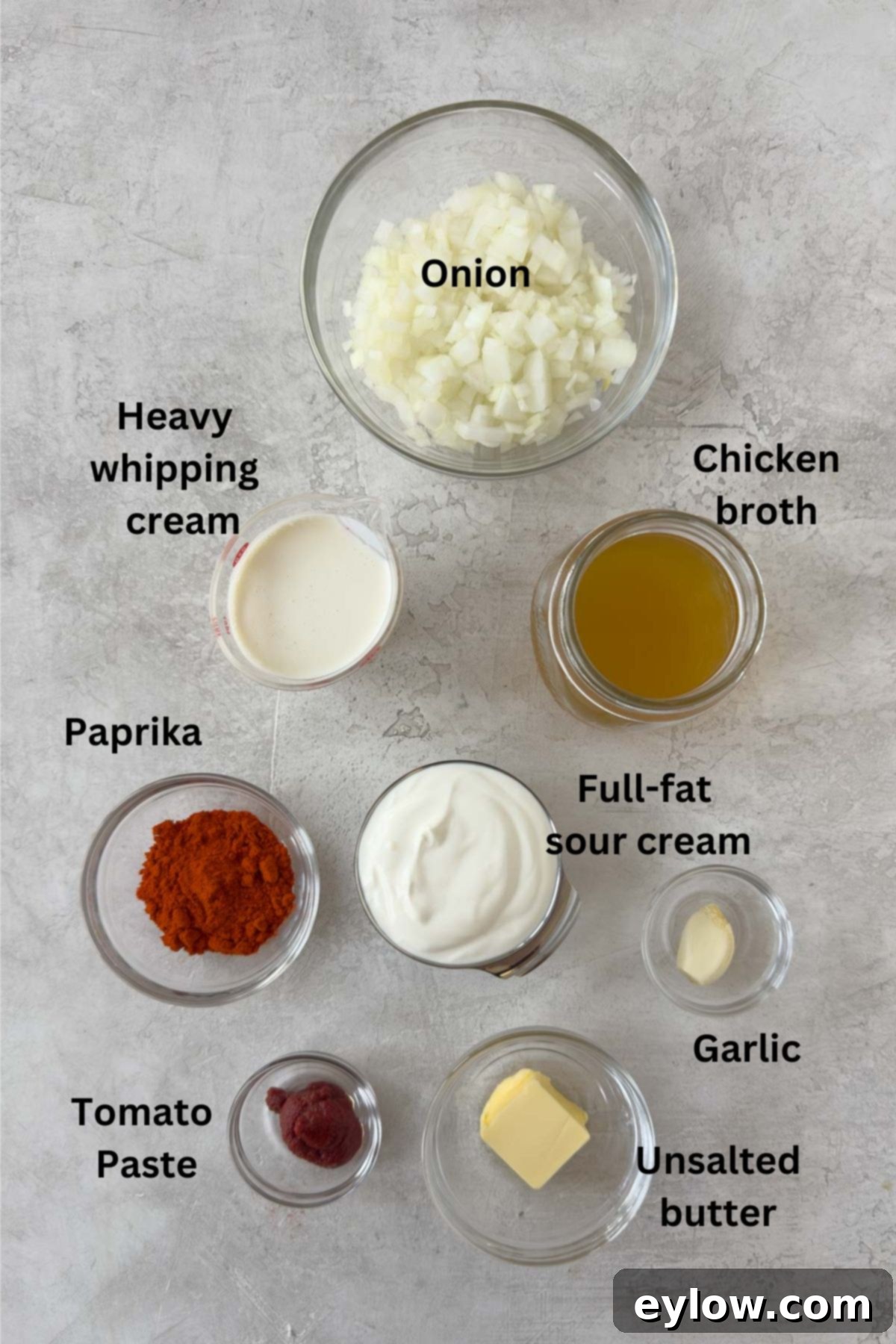
- Paprika: As the star of the show, invest in fresh Hungarian sweet paprika. This variety is most commonly used in traditional Hungarian cuisine for its mild, sweet, and earthy flavor profile, which contributes significantly to the sauce’s characteristic taste and brilliant color. Look for it in specialty spice stores or reputable online sources, as their quality often surpasses what’s available in standard grocery aisles.
- Unsalted Butter: Butter provides a rich base for sautéing the aromatics and adds a luxurious mouthfeel to the sauce. Using unsalted butter is crucial because it gives you complete control over the overall saltiness of the dish, allowing you to season it perfectly to your preference.
- Onion: Onions are a cornerstone of Hungarian cooking, providing a foundational sweetness and aromatic depth. Opt for yellow, brown, or white onions. It’s important to avoid red onions, as their stronger, more pungent flavor is not traditional for this sauce and can easily overpower the delicate paprika.
- Garlic: A single clove of fresh garlic is all you need. Hungarian cooking typically uses garlic with a light hand, ensuring it complements rather than dominates the paprika flavor. Finely chopping it allows its essence to meld seamlessly into the sauce.
- Tomato Paste: This concentrated ingredient is a powerhouse, adding a rich umami depth, enhancing the sauce’s vibrant red-orange color, and contributing a subtle sweetness that helps to balance the flavors while also acting as a natural thickener.
- Broth: Use low-sodium chicken broth or, for a vegetarian option, a high-quality homemade vegetable broth. The broth thins the sauce to the right consistency and adds another layer of savory flavor without overwhelming the paprika.
- Heavy Cream: Essential for that signature rich and creamy texture. Choose heavy cream or heavy whipping cream for the best results, as their high-fat content ensures a stable and luscious sauce.
- Sour Cream: No Hungarian paprika sauce would be complete without sour cream! It introduces a characteristic tangy finish that beautifully cuts through the richness of the cream and paprika, adding a complex layer of flavor. Always use full-fat sour cream; low-fat versions are prone to breaking or curdling when heated.
For precise measurements and detailed salt recommendations, please refer to the comprehensive recipe card provided below.
Customizing Your Creamy Paprika Sauce: Substitutions and Flavor Variations
While this recipe delivers an authentic and classic paprika sauce, there are several ways to adapt it to your taste or dietary needs. One specific note: I intentionally omit black pepper from this recipe to preserve the beautiful, unblemished orange color of the sauce. If you desire a peppery kick, a small amount of white pepper is a great alternative, as it won’t introduce black specks.
- Smoky Flavor Twist: For a delicious but non-traditional variation, incorporate a portion of smoked paprika powder. This will infuse the sauce with a deep, smoky aroma and flavor, adding a rustic character that pairs wonderfully with grilled meats.
- Heat It Up: If you prefer a spicier sauce, replace a portion of the sweet paprika with hot Hungarian paprika. Start with a small amount (e.g., ½ teaspoon) and adjust to your desired level of heat.
- Creme Fraiche for Stability and Tang: For a richer flavor and even greater heat stability, consider using creme fraiche in place of full-fat sour cream. Creme fraiche has a higher fat content and a milder tang, making it less likely to curdle when introduced to heat.
- Post-Cooking Spice: If you decide the sauce needs more heat after tasting, stir in a dash of your favorite hot sauce at the very end. This allows for precise control over the spice level without altering the core flavors during cooking.
- Herbaceous Notes: While not traditional, a hint of fresh dill or parsley, stirred in at the end, can add a refreshing aromatic layer.
For another delectable creamy sauce that complements rich proteins, explore this recipe for roast pork tenderloin with a luscious mustard cream sauce.
Chef’s Tip on Paprika Varieties: A Deeper Dive: Understanding the different types of paprika is key to mastering this sauce and other Hungarian dishes.
- Sweet Paprika (Édesnemes): This is the most widely used variety in Hungarian cuisine, characterized by its bright red color and a mild, slightly sweet, and earthy flavor derived from sweet mild red peppers. It forms the backbone of traditional paprika sauce.
- Hot Hungarian Paprika (Csípős Csemege): Made from hotter varieties of peppers, similar to cayenne pepper or other chili peppers, this type adds a noticeable kick. It’s often used alongside sweet paprika to achieve a more balanced flavor with a touch of heat.
- Rose Paprika (Rózsa): This is a milder and more aromatic paprika, known for its pale red color and delicate, slightly sweet, and floral notes, often made from the middle parts of the pepper.
- Smoked Paprika (Pimentón): Predominantly Spanish, smoked paprika is made from peppers dried over oak fires, imparting a distinct smoky depth. While not traditional in classic Hungarian recipes, it can be a fantastic modern twist for those who enjoy a smoky flavor in their paprika sauce. It adds a delicious layer but will shift the sauce away from a purely authentic Hungarian profile.
Knowing these distinctions empowers you to choose the perfect paprika for your culinary creations!
Step-by-Step Guide: Crafting Your Creamy Paprika Sauce
Follow these detailed instructions to create a flawless and flavorful paprika sauce. Precision and patience ensure the best results, allowing the flavors to meld beautifully at each stage.
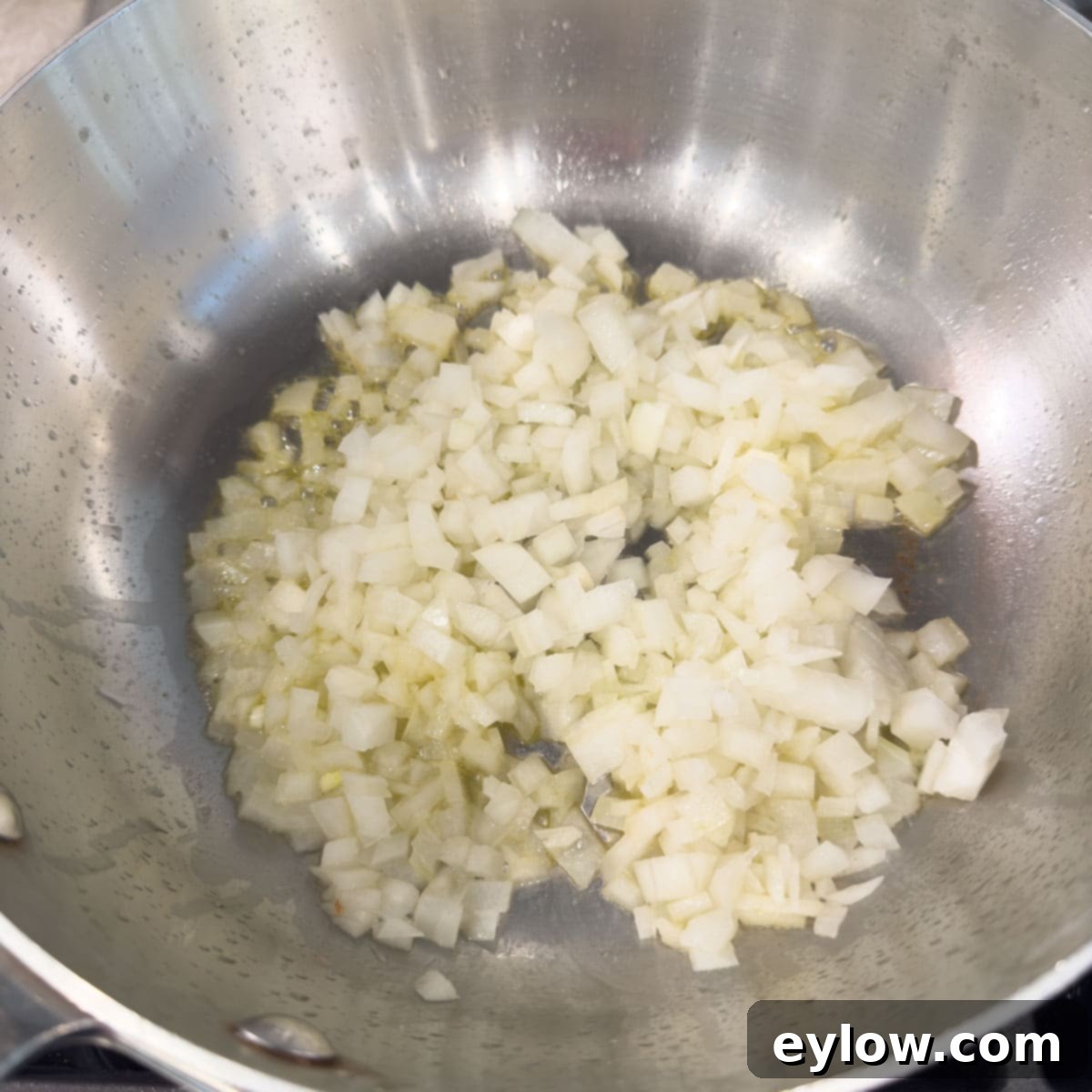



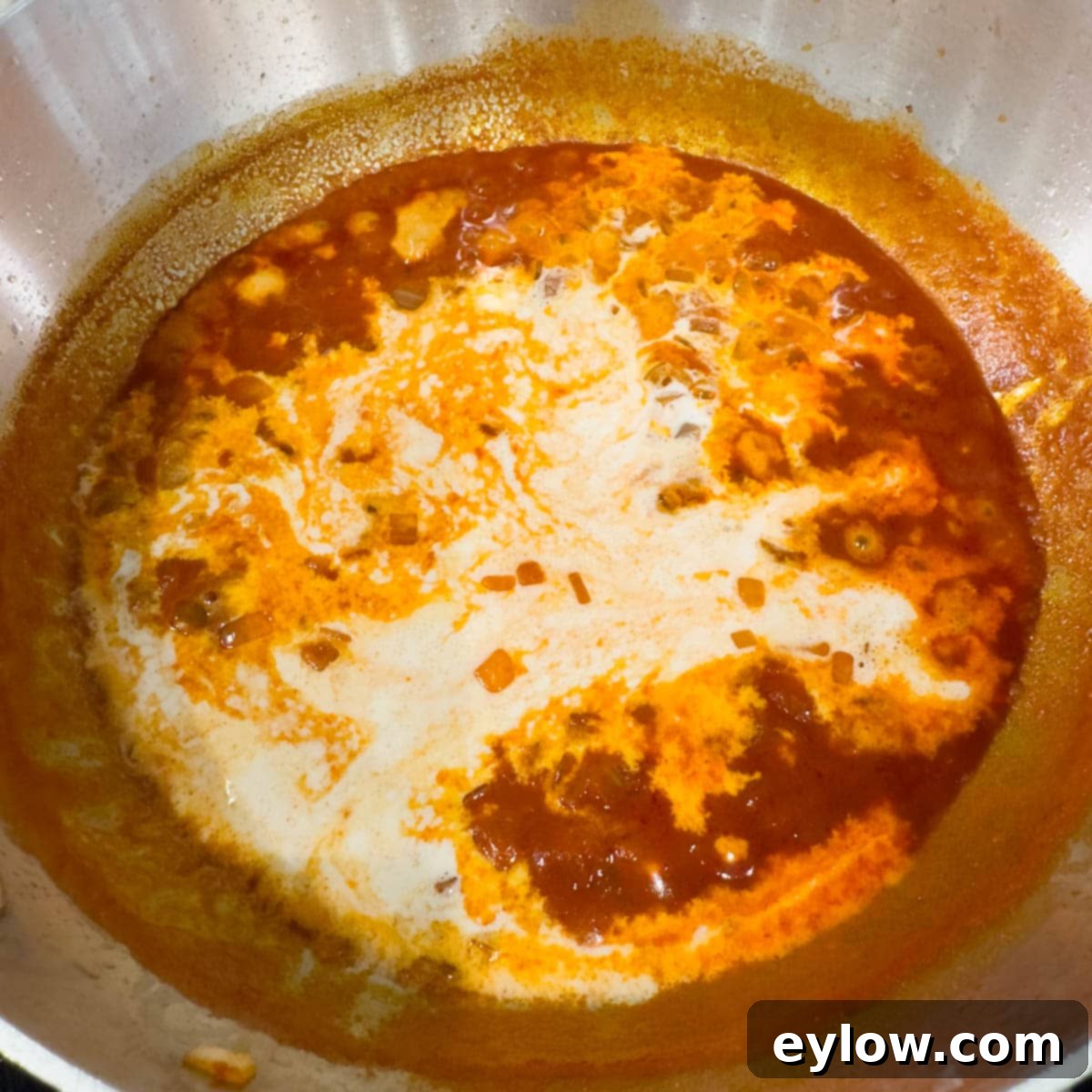

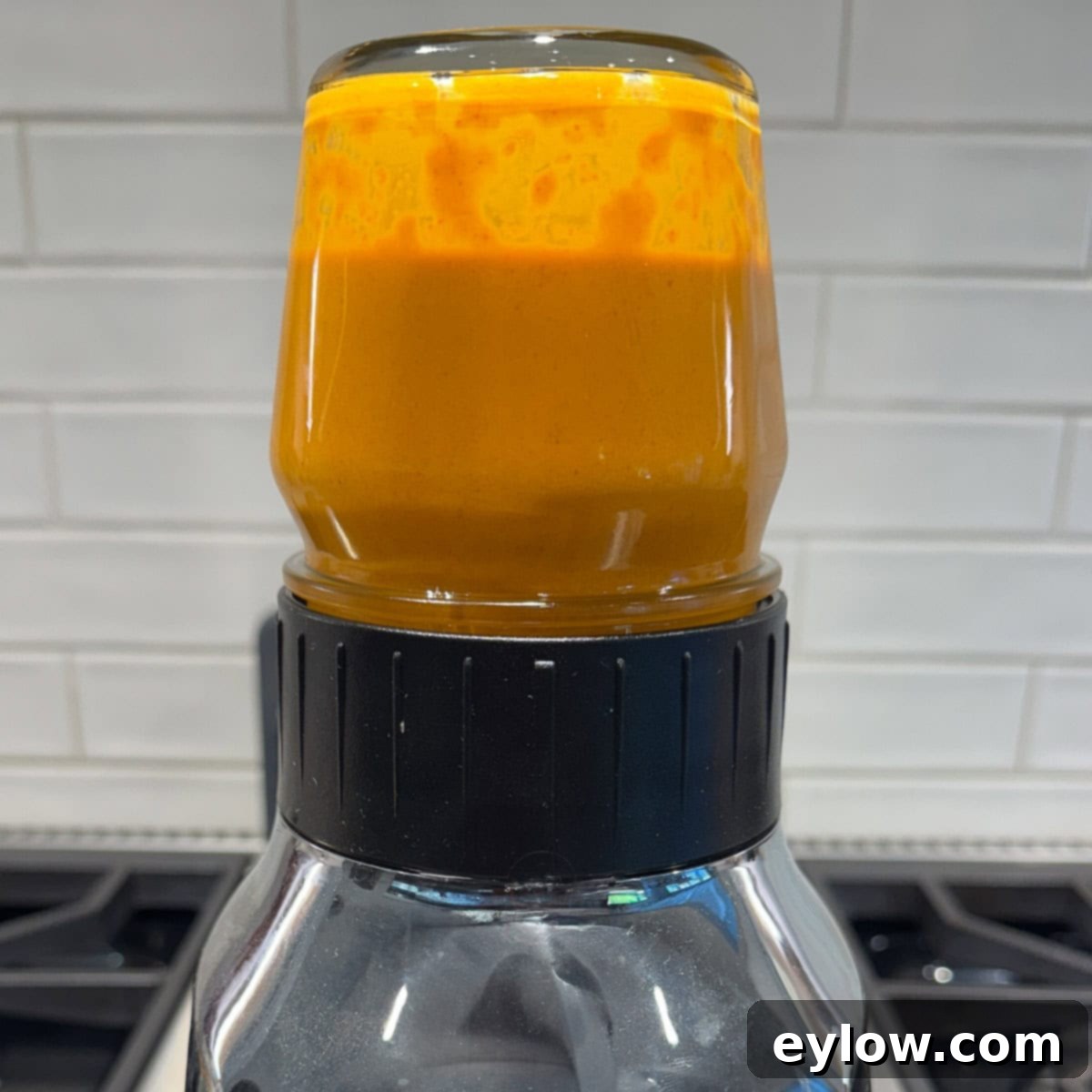
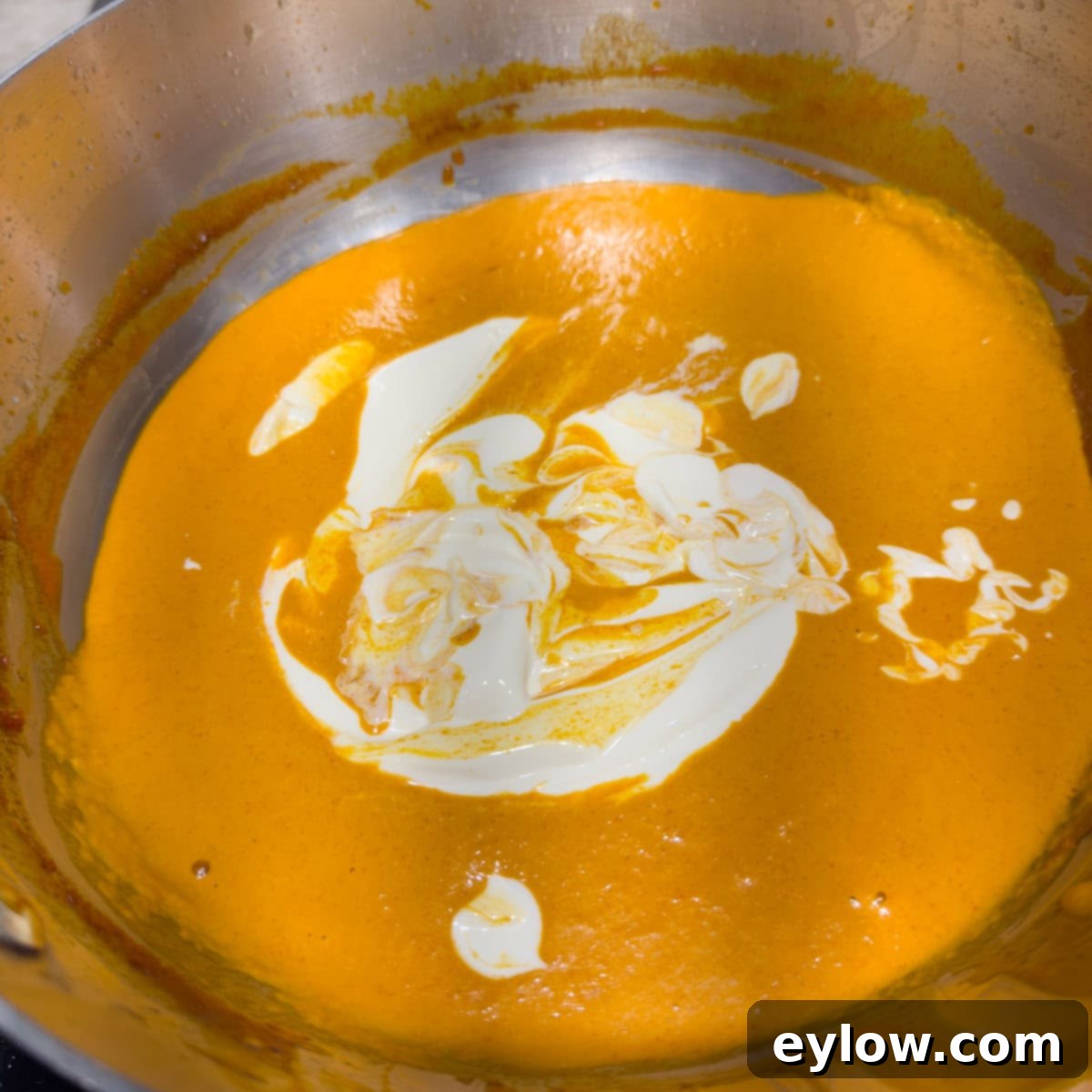
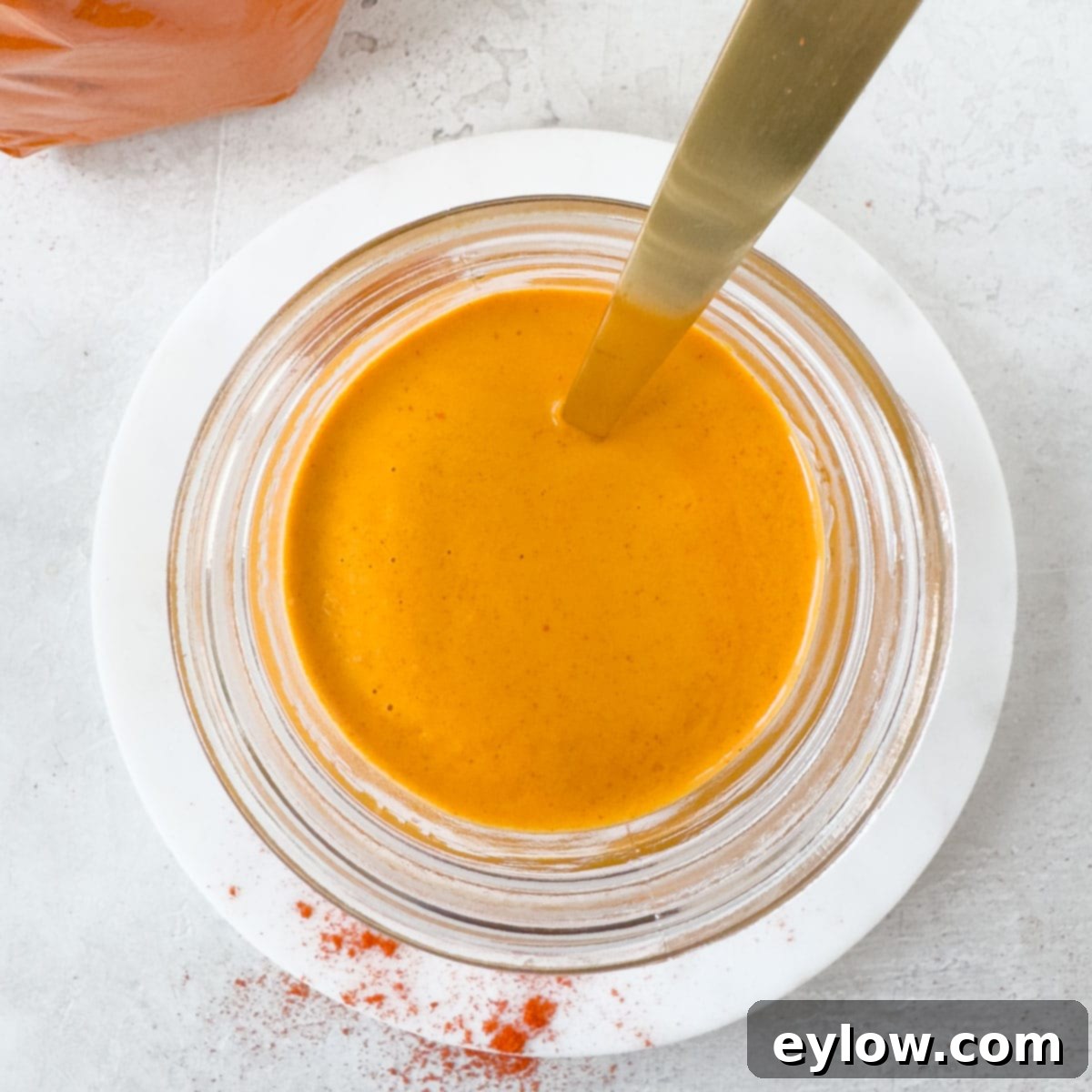
Chef’s Tool Tip: The Indispensable Saucier Pan: For making this paprika sauce, and many other delicate sauces, I highly recommend using a 3-quart saucier pan. Unlike traditional saucepans that feature sharp, 90-degree corners, saucier pans are designed with gently curved sides. This ergonomic design is a game-changer for sauce-making, as it eliminates areas where ingredients can get stuck or burn, making it significantly easier to stir, whisk, and emulsify your sauce smoothly and efficiently. Food won’t cling to the edges, ensuring even cooking and blending. It’s a truly versatile and valuable addition to any kitchen collection, proving equally excellent for dishes like risotto, gravies, and custards. Saucier pans are also notoriously easy to clean, further adding to their appeal.
Elevate Your Meals: Creative Serving Suggestions for Paprika Sauce
This rich and creamy paprika sauce is incredibly versatile, capable of transforming a simple dish into a memorable culinary experience. Its luscious texture and vibrant flavor make it an ideal companion for a wide variety of foods. Here are some inspired serving ideas:
- With Meats: It’s a spectacular way to dress up simple roasted, grilled, or pan-seared lean meats. Think of it over a perfectly cooked grilled flank steak, a tender pork tenderloin, or even a classic schnitzel. The sauce’s richness beautifully complements the savory notes of the meat.
- Chicken Perfection: Elevate everyday chicken dishes. Drizzle it over simple grilled, roasted, sautéed, or smoked chicken breast. It turns an easy chicken recipe into an extraordinary one, adding moisture and an incredible depth of flavor.
- Fish and Seafood Delights: Lean fish and seafood often benefit from an added layer of richness and flavor. Paprika sauce is fantastic with halibut, cod, mahi-mahi, or even easy baked shrimp. It provides a creamy contrast that highlights the natural sweetness of the seafood.
- Breakfast & Brunch Boost: Don’t limit this sauce to dinner! It’s unexpectedly delicious with eggs. Try it generously spooned over poached eggs as a flavorful alternative to hollandaise sauce for Eggs Benedict, or incorporate it into a fluffy omelet for a Hungarian-inspired breakfast.
- Vegetable Enhancement: Roasted or steamed vegetables like asparagus, green beans, or potatoes take on new life with a dollop of this sauce. It’s also superb over hearty root vegetables.
- Pasta and Grains: Toss it with plain pasta, rice, or couscous for a simple yet satisfying meal. Add some sautéed mushrooms or spinach for a complete vegetarian dish.
Make Ahead and Storage Tips: I generally prefer to make this paprika sauce ahead of time. When reheating, do so gently over very low heat in a small pan. It’s crucial not to let the sauce get too hot, as the sour cream content can cause it to “break” or separate. If this happens, don’t despair! A vigorous whisking can often bring it back together. Store any leftover paprika sauce in an airtight container in the refrigerator for up to 4-5 days. Due to its dairy content, this sauce is unfortunately not suitable for freezing, as freezing and thawing can significantly alter its creamy texture.
Frequently Asked Questions (FAQs) About Paprika Sauce
Here are answers to some common questions about making and enjoying this delicious paprika sauce, providing extra insights to ensure your success and culinary enjoyment.
Traditionally, Hungarian paprika sauce is made with sweet paprika (often labeled Édesnemes). This provides the characteristic vibrant color and a mild, earthy, slightly sweet flavor. To introduce a gentle heat, you can add a small amount of hot paprika alongside the sweet variety. While not traditional, using smoked paprika can offer a wonderful, modern twist, imparting a deep, rustic flavor. Feel free to experiment with different types to discover your preferred flavor profile!
This rich and creamy sauce is incredibly versatile. It’s an excellent accompaniment for lean grilled or roasted meats like pork tenderloin, chicken breasts, and even lamb. It also beautifully complements fish and various seafood (e.g., cod, halibut, shrimp), adding a touch of richness. Don’t forget vegetables; it’s delicious drizzled over roasted potatoes, green beans, or asparagus. For breakfast or brunch, it’s superb with eggs, serving as a flavorful alternative to Hollandaise sauce for Eggs Benedict or stirred into omelets. Its creamy texture makes it a comfort food hero.
Yes, paprika sauce can certainly be served cold, making it an interesting dip or spread. When refrigerated, its fat content causes it to thicken considerably, almost to a spreadable consistency. If you wish to use it as a cold sauce, you might want to thin it down slightly with a splash of broth or milk to achieve a pourable consistency. It can be a unique addition to charcuterie boards or as a sandwich spread.
Paprika sauce, especially after adding sour cream, can sometimes “break” or separate if it gets too hot. The key is gentle reheating. If it does separate, don’t worry! First, try whisking it vigorously and continuously over very low heat to re-incorporate the elements. If that doesn’t fully work, transferring it to a blender and blending on low speed for 15-30 seconds can often rescue the sauce, restoring its smooth emulsion. For future preparation, using creme fraiche instead of regular full-fat sour cream can help, as its higher fat content and different protein structure make it more stable and less prone to breaking in sauces.
While both are derived from ground dried peppers, Spanish paprika (Pimentón) and Hungarian paprika differ significantly in flavor, smokiness, and heat levels due to distinct pepper varieties and production methods.
Spanish Paprika is typically characterized by a smoky, rich, and often sweet flavor, resulting from drying the peppers over oak fires. This process gives it a deeper, darker red color and a robust aroma, making it central to many Spanish dishes.
Hungarian Paprika, on the other hand, is usually unsmoked, allowing the natural sweetness and vibrant pepper taste to shine through. It tends to be sweet, earthy, and sometimes fruity, with a bright red color. Both are fantastic spices and deserve a prominent place in any well-stocked spice cabinet, but their unique profiles lend themselves to different culinary applications.
While the traditional recipe relies heavily on dairy for its characteristic creaminess and tang, you can adapt it to be dairy-free. Replace butter with olive oil or a plant-based butter alternative. For heavy cream, use full-fat coconut milk (from a can, not a carton) or a dairy-free heavy cream substitute. For sour cream, a good quality dairy-free sour cream alternative or even a cashew-based cream can work. Be aware that these substitutions will alter the flavor profile and consistency slightly, but you can still achieve a delicious and rich sauce.
If your paprika sauce turns out too thick, you can easily thin it by whisking in a little extra chicken or vegetable broth, or even a splash of milk or cream, until it reaches your desired consistency. Do this over low heat. If the sauce is too thin, you can thicken it by simmering it gently for a few more minutes to allow some of the liquid to evaporate. Alternatively, you can mix a small amount of cornstarch (about ½ teaspoon) with an equal amount of cold water to create a slurry, then whisk it into the simmering sauce and cook for another minute until thickened. Remember to add thickeners gradually to avoid over-thickening.
Explore More Super Sauce Recipes
Sauces are the unsung heroes of the culinary world, possessing the magical ability to transform even the most basic ingredients into something incredibly exciting and delicious. Don’t stop at paprika sauce; broaden your flavor horizons with other fantastic homemade creations. Be sure to check out our comprehensive sauce recipes index page for more inspiration and guidance on crafting perfect condiments for any meal!
- Gluten-Free BBQ Sauce Recipe
- The Best Roasted Tomato Sauce
- Tomatillo Sauce (green enchilada sauce)
- No-Cook Asian Dipping Sauce With Almond Butter
Did You Make This Exquisite Paprika Sauce?
Your feedback means the world to us and helps fellow home cooks! If you tried your hand at making this creamy paprika sauce, please take a moment to leave a comment below and let us know your thoughts. We’d love to hear how it turned out for you. If you absolutely loved it and it became a new favorite, please consider giving it a 5-star rating. Your ratings are incredibly helpful to other readers searching for delicious recipes, and we genuinely enjoy hearing about your culinary successes!
📖 Recipe: Classic Hungarian Paprika Sauce

Paprika Sauce
Sally Cameron
Prevent your screen from going dark
Pin Recipe
5 minutes
20 minutes
25 minutes
Sauce
American, Hungarian
8
Yield 1 ¾ cups
90
kcal
Ingredients
-
2
tablespoons
unsalted butter -
¾
cup
chopped onion
½ medium onion -
1
small
garlic clove
finely chopped -
1
tablespoon
tomato paste -
1 ½
tablespoons
paprika
sweet paprika -
½
cup
chicken broth
low sodium or homemade -
½
cup
heavy whipping cream -
⅓
cup
full fat sour cream -
¼
teaspoon
sea salt
or more to taste
Instructions
-
Melt the unsalted butter in a medium (3-quart) saucepan over medium-low heat. Add the finely chopped onion and cook until the onion softens and becomes translucent, but do not allow it to brown, which typically takes about 3 minutes. Stir in the minced garlic and continue cooking for another 30 to 60 seconds, being careful not to burn the garlic.
-
Stir the tomato paste into the onion and garlic mixture. Cook for 2 minutes, stirring frequently, to allow the tomato paste to deepen in flavor and color. Immediately add the sweet paprika and stir it thoroughly into the mixture. Continue to cook for another 2 minutes, stirring constantly. This step “blooms” the paprika, intensifying its color and releasing its aromatic oils and full flavor. Ensure the heat is not too high to prevent the paprika from burning, which can make it bitter.
-
Pour in the chicken or vegetable broth and slightly increase the heat. Bring the sauce to a gentle simmer and cook for 2-3 minutes, allowing the flavors to meld and the mixture to reduce slightly. Next, stir in the heavy cream and the initial ¼ teaspoon of sea salt, continuing to stir until the sauce is completely smooth. Allow it to cook for an additional 2 minutes, still at a gentle simmer, to thicken to a luscious consistency. For an ultra-smooth finish, carefully transfer the sauce to a blender and puree for 20-30 seconds.
-
To finish the sauce, return the pureed mixture to the pan over very low heat. Stir or whisk in the full-fat sour cream until it is smoothly incorporated and the sauce is warmed through. Avoid bringing the sauce to a boil after adding the sour cream, as this can cause it to separate. Taste the sauce for seasoning and adjust with additional salt if desired, ensuring it meets your preference. Serve immediately and enjoy!
Notes
Chef’s Note: I’ve extensively tested this sauce with varying amounts of heavy cream: ¼ cup, ½ cup, and ¾ cup. While all three yields a delicious sauce, ½ cup consistently strikes the optimal balance, providing a wonderfully rich and creamy texture without overwhelming or muting the authentic, delicate flavor of the paprika. If you prefer a slightly lighter sauce, you can use ¼ cup. For an even richer, more intensely velvety result, opt for ¾ cup, especially if serving with heartier dishes.
Optional Enhancements and Customization Ideas:
- Smoky Variation: Introduce a portion of smoked paprika powder for a delicious, deeper flavor profile, though this will deviate from the classic Hungarian tradition.
- Add Heat: For a spicier sauce, substitute a small amount of sweet paprika with hot Hungarian paprika to taste.
- Post-Cook Spice: If you find the sauce needs more kick after cooking, stir in a dash of your favorite hot sauce just before serving.
- Tang Adjustment: Begin with ⅓ cup of sour cream as suggested. If you desire a more pronounced tanginess or a richer finish, gradually add a little more sour cream until it perfectly suits your preference.
Making Ahead and Reheating: This paprika sauce can be prepared in advance. When reheating, do so very gently over low heat in a small saucepan. Be cautious not to overheat the sauce, as the dairy content (especially sour cream) can cause it to “break” or separate. If separation occurs, quickly whisk the sauce vigorously to help re-incorporate the elements.
Storage: Store leftover paprika sauce in an airtight container in the refrigerator for up to 4-5 days. Due to its dairy components, this sauce does not freeze well; freezing and thawing will likely result in a grainy or separated texture.
Nutrition
Calories:
90
kcal
Carbohydrates:
3
g
Protein:
1
g
Fat:
8
g
Saturated Fat:
5
g
Polyunsaturated Fat:
0.5
g
Monounsaturated Fat:
2
g
Trans Fat:
0.1
g
Cholesterol:
24
mg
Sodium:
99
mg
Potassium:
101
mg
Fiber:
1
g
Sugar:
1
g
Vitamin A:
983
IU
Vitamin C:
2
mg
Calcium:
19
mg
Iron:
0.4
mg
Tried this recipe?
Let us know how it was with a comment and leave a star rating!
